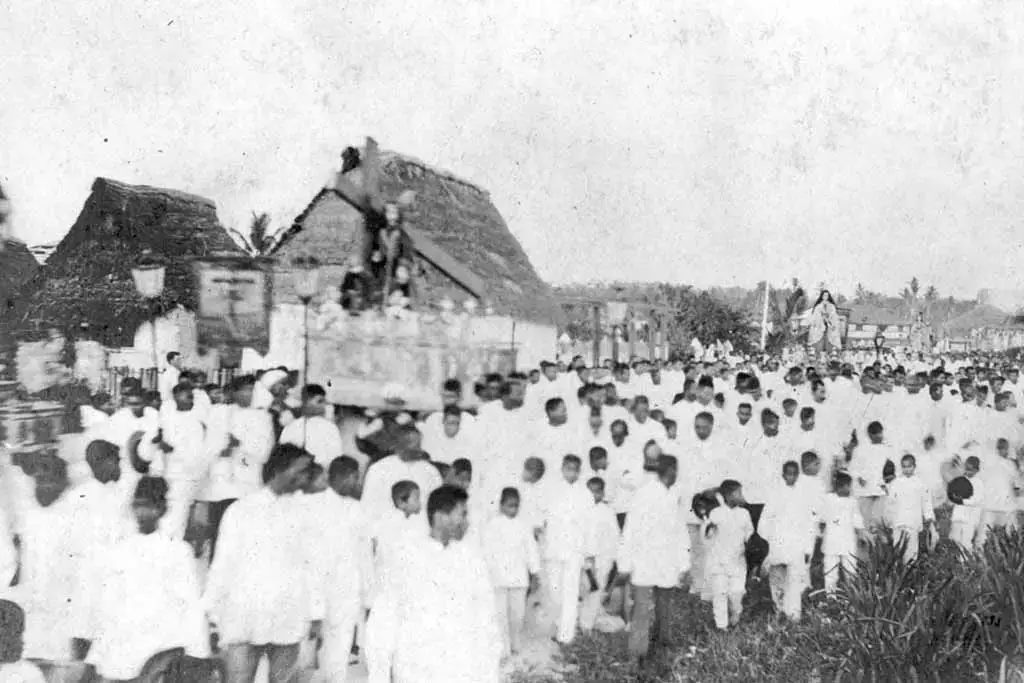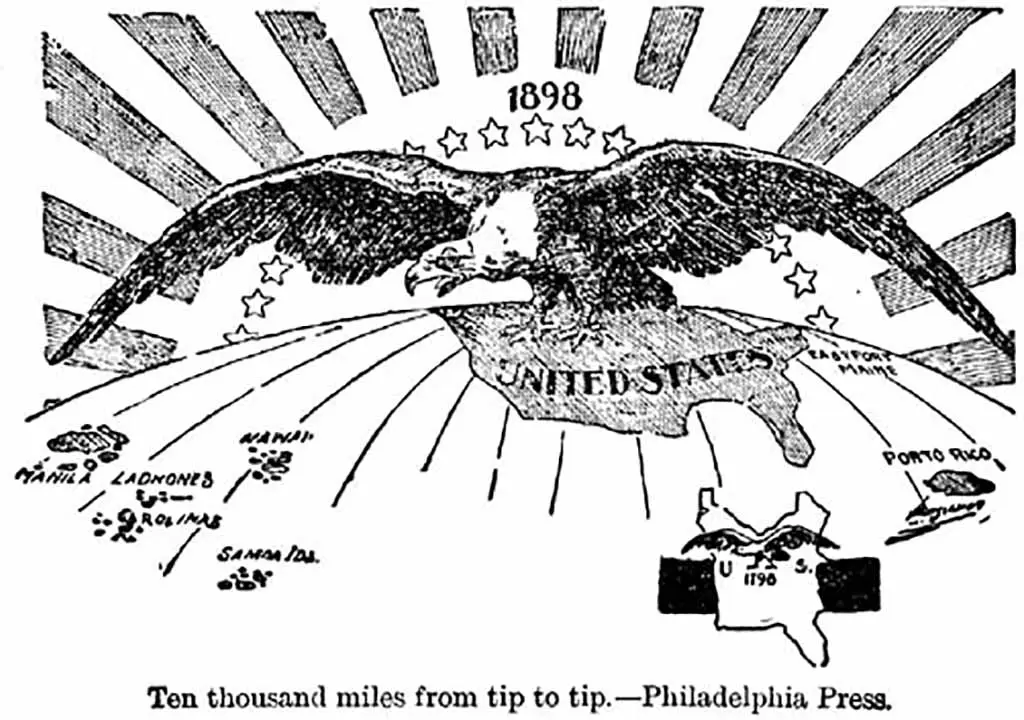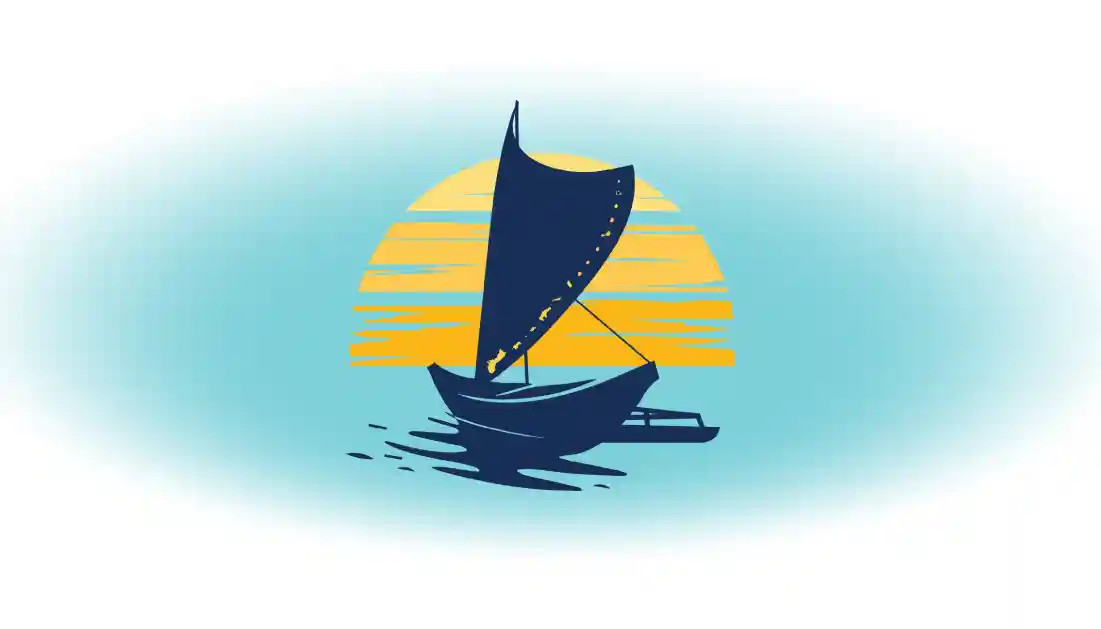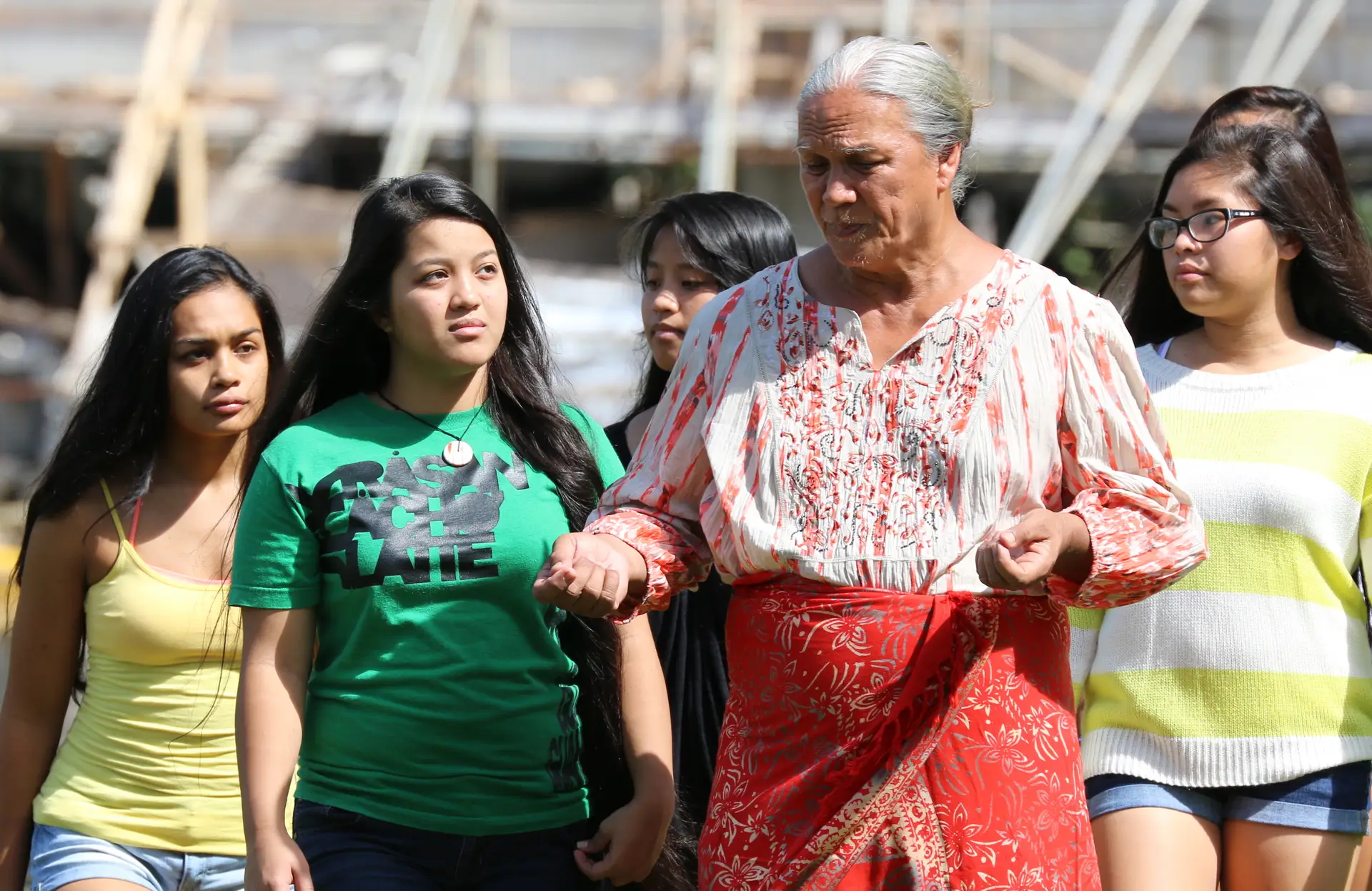Marianas Pathway
Table of Contents
Introducing the Mariana Islands
The Mariana Islands are the homelands of the indigenous CHamoru/Chamorro people. The archipelago was first populated some 3,500 years ago. The Mariana Islands were unified under a shared culture and history from when our ancestors first settled the archipelago up until 1898 when new colonial powers took over. Our shared history and culture spanned from first settlement up until 1898 with the new colonial powers taking over.
Although today the islands of the Northern Marianas and Guam are politically separated, we are still connected through a vibrant culture and language, as well as shared ancestry, family genealogies, and stories of place. Located in the Western Pacific region of Micronesia, the Marianas archipelago is composed of 15 islands. The larger, populated islands are Saipan, Tinian, and Rota in the north and Guam in the south.
This pathway invites you to traverse the history and heritage of Guam and the Commonwealth of the Northern Mariana Islands. In this pathway, you can find the Guampedia timeline which marks significant milestones in our historical journey, educational resources from scholars and cultural practitioners from across the archipelago, and community projects demonstrating how our Chamorro cultural values continue to shape our ways of life. The Marianas pathway is here to help you navigate through the rich heritage and history of our islands, and their unique position in the Pacific.

Marianas environment
From limestone forests and lush valleys to waterfalls and coral reefs, the natural environments of the Marianas have sustained the Chamorro people for thousands of years. You can learn more and access entries about natural environments of the Marianas here!
Our oceans
The Mariana Trench, located some 200 kilometers east of the Mariana Islands, is the deepest oceanic trench on earth. The oceans surrounding our archipelago are home to hafula’ yan halu’u (rays and sharks), tuninos (dolphins), and bayena (whales). The haggan, or green sea turtle, was once commonly found in our waters. Chamorros historically used turtle shells to craft jewelry, while turtle bones were used to make tools and turtle meat was eaten traditionally at ceremonial events. Hima (giant clams) are also culturally significant, archaeological findings reveal that clams were used as tools such as higam (adzes), guesgues (scrapers), and se’se’ (knives). Giant clams were also used to create the sinåhi, a crescent moon jewelry pendant that still holds cultural significance today. The higam was an important tool because it was used to build the sakman (canoe) that allowed Chamorros to fish and travel to neighboring islands. Chamorros were known for their speed and agility while navigating the open ocean.
Our lands
The ancient Chamorros who first settled in the archipelago adapted to a tropical environment while undergoing frequent typhoons, times of drought, and even occasional earthquakes and tsunamis. Scientists have learned that the archipelago experienced significant changes in both sea level and landscape topography over time, which affected the human settlement patterns and the kinds of plants and animals that thrive here. The Marianas has a tropical and humid climate, defined by periods of rainy (July – October) and dry (January – April) seasons. The ancient Chamorro calendar, which follows the phases of the moon, also reveals how our ancestors organized their lives around the changes of the environment. For example, Lumåmlam, which corresponds with the month of September in the Gregorian calendar, means “season of lightning,” while Fangguålo’ (October) means “planting season,” and Sumongsong (November) can be interpreted to mean “season to repair the nets, stay in the village.” This teaches us how a culturally rooted understanding of our natural environment can provide deeper insights.
Fish and Wildlife Fact Sheets
Guam’s Fish and Wildlife Fact Sheets made 80 fact sheets containing images and text describing the island’s species that live on land and in the ocean surrounding the Marianas. Each one names the species or organism in Chamorro and English. Some sheets indicate if the species is introduced to the islands, if it is endangered or if it is an extinct species. The sheets also have photos and/or illustrations showing the species in its natural habitat. They provide information on the origins, habitat, diet and season for harvesting or hunting. View fact sheets here.

Pacific Origins and the Arts
Note: Read more from POP Cultures
Austronesian-speaking peoples moved into the Micronesian islands of the Marianas and Palau about 4,0000 years ago, and began populating the Caroline and Marshall Islands about 2,000 years later. As the different cultures evolved in each of these Micronesian regions, distinctive art forms and characteristics also developed and changed. Utilizing materials that were available to them, they fashioned objects that were significant both aesthetically and symbolically.
The early settlers of the Marianas also had a unique pottery style, broadly named Marianas redware, with lime-incised decorations. Some scientists believe a second wave of migration into the Marianas about 1,000 years ago may have led to the distinct culture that produced the iconic latte stones of the Chamorro people.
The ancestors of the Pohnpeians were also builders of iconic stone architecture, and constructed the impressive series of channels and platforms known as Nan Madol.
Archaeology of the Marianas
Guampedia, the Richard F. Taitano Micronesian Area Research Center University of Guam, and Guam Preservation Trust are pleased to collaborate on this collection of essays on archeological knowledge of the Marianas.
There has been a lot of archeological investigation in the Marianas. There are nearly a thousand archeological reports, but most of these were done to satisfy the historical preservation laws that require studies on many development projects. The sheer number of these is impressive, but in themselves they are not accessible or meaningful to the general reader. They are often more about the law or the specific development than they are about the general knowledge of archeology. The essays in this section provide an update to the earlier studies and distill the present state of archaeological knowledge from the mass of previous work. Click here to learn more!
Historical Timelines
Guampedia Timeline
Inhabited for more than 3,500 years, the Marianas are home to one of the oldest Pacific Island cultures. Archaeological evidence indicates that the Marianas Islands were one of the first places to be settled by seafaring peoples, possibly from Island Southeast Asia. Although it is uncertain whether the islands were settled in waves of migration or all at once, the Mariana Islands appear to have been continuously occupied by people who shared the same culture and language that eventually became known as CHamoru/Chamorro.
For learning purposes we’ve broken Guam’s history into seven eras – Ancient, Spanish, US Naval, World War II, Post War, Guamanian and Contemporary.Learn about the 3,500 years of Guam history here or view our timeline here.

Religion and cultural practices
An interpretive essay: In the beginning. There is little doubt that CHamorus/Chamorros today live very different lives than Chamorros did 400 years ago, and have different ideas about what is and isn’t Chamorro culture. We would be hard pressed however, to find any culture which didn’t change drastically in some ways, over such a long period of time. Click here to learn more about the transmission of Christianity into Chamorro culture.
First Catholic schools
In addition to the evangelization of the Mariana Islands, the Jesuits introduced a European system of education to Chamorros. The Colegio de San Juan de Letrán, a school for boys in Hagåtña, was established by Father Diego Luis de San Vitores, a Jesuit priest who arrived on Guam in 1668 and established the first Catholic mission in the capital city of Hagåtña.
Christianization was first priority
The early missionaries in the Mariana Islands baptized thousands of Chamorros. Despite resistance among many Chamorros and the widespread bloodshed and death that resulted, a majority of the population of the Marianas throughout the first century of Spanish rule in the islands were eventually converted to Christianity.

Partition of the Marianas
The Marianas archipelago was first inhabited some 3,500 years ago by people who originally came from Southeast Asia. The indigenous inhabitants are known as Chamorros/CHamorus, and today the archipelago is politically separated. Guam, the largest island in the south, is organized as an unincorporated territory of the US, while the Northern Mariana Islands are organized as a Commonwealth of the US.
The archipelago was colonized by Spain in 1668, and Spanish colonialism provided a form of unified political organization. After the Spanish-American War, the entire Philippine and Hawaiian archipelagoes were seized by the US in 1898. However, in the case of the Marianas, only Guam was taken by the US. Why only Guam — why not all of the Marianas? How did the US become a Pacific colonial power in the first place? Scholar Don Farrell explores this question and the history of political partition in his entry, read more here.
History of Efforts to Reunify the Mariana Islands
Despite the best advice from naval officers who had been in the region since Commodore Matthew C. Perry opened Japan in 1853, President William McKinley chose to give a portion of America’s spoils of war to a European nation that did not even participate in the war. The decision allowed Japan to capture the Northern Mariana Islands from Germany in 1914, and ultimately to choose war against the US in 1941. Today, the partition of the Marianas archipelago costs American taxpayers, in both the Marianas and the mainland, millions of dollars annually to maintain two separate territorial governments for essentially one people—not to mention the price of aggravations created over inter-island commerce and taxation. Significant efforts have been made to reunify the Marianas since that artificial line was drawn through the Rota Channel 115 years ago. Why have they failed? Is reunification still a viable political status option? Learn more about efforts to reunify the Marianas here.

Art in the Mariana Islands
Little is known about the history of art or artistic movements in the Mariana Islands before the turn of the 20th century. Traditional practices of canoe-building and pottery-making were largely forgotten as Spanish colonialism and influences from Spain, Germany, the Philippines, Mexico, Japan and the United States altered the cultural landscape of the Chamorro people. However, some traditions, particularly weaving, storytelling and music remained, although somewhat changed with the passage of time.
With new cultural influences came new ways of producing items used in everyday life and for enjoyment. Blacksmithing and metal work, for example, produced tools that made building structures or processing foods much easier than earlier methods. Musical instruments and dances from around the world made their way to the Marianas with each new administration. By the 20th century, the introduction of newspapers, radio and television brought even more ideas for artistic expression and possibilities to explore the latest musical genres, theatrical performances, art movements and dance. Learn more about art and creative expressions here.

Marianas History Conference
One Archipelago, Many Stories. In 2011 a group of like minded people from the Mariana Islands decided it was high time to have a Marianas History Conference, one that focused specifically on the history and experiences of the people of all the Mariana Islands. The initial group of organizers, led by Scott Russell of the Northern Marianas and Rosanna Barcinas of Guam, met in August and came up with the theme, “One Archipelago, Many Stories.” The theme highlighted the deep and rich history of the Mariana Islands, and bridged the political division of the archipelago–a division that exists today. Learn more here.
Marianas History Conference Proceedings

Voices of Our Elders
Our Manaina
Anyone who has grown up in a Chamorro household on Guam or the Northern Mariana Islands likely can attest to the importance the elders, our manaina, have in our families. Parents, grandparents and the older generations of aunts, uncles and cousins, grow in status because of their age and experience. We respect them for their wisdom and recognize them as keepers of Chamorro traditions, customs, genealogy, history, landholdings, crafts, and family secrets. They are often our first teachers. They taught us the Sign of the Cross (in Catholic households) and how to pray; they showed us how to cook favorite family dishes, and shared special crafts they knew, like weaving, sewing or carving. They told us stories of their lives growing up. They taught us to respect others and reminded us of our responsibilities to the family and to the rest of our community. If we were fortunate enough, they spoke to us in Chamorro. Growing up, we were taught not only to respect our elders, but to care for them when they become too old to take care of themselves. And there is always much sadness when an elder passes away.
Children in the Marianas are taught early on to show respect to their elders. They sniff their saina‘s slightly raised hand (‘nginge) or kiss their cheek, while referring to them as “Ñot” or “Ñora,” and receiving their praise and blessing—or “Dioste ayudi”—in return. Being around the elders, the manaina (or man’amko), and listening to what they have to say, help keep the Chamorro culture alive, ready to pass on to the next generation.
“Hinenggen Chamorro”
The Hinenggen Chamorro: The Faith of the Chamorro People Before the War” Exhibit was an exhibit of religious images and artifacts assembled and curated by Pale’ Eric Forbes, OFM Cap., a Chamorro Catholic priest and an avid researcher of Guam and Marianas history. The exhibit was held at Government House from February to March 2014 in commemoration of Chamorro Month and featured historic images, icons and religious displays of predominantly Catholic (but also General Baptist) objects that reflect the strong Christian faith of Guam’s people from this era. Hinenggen Chamorro was well-received by many who visited the exhibit because of the rarity of its pieces and the unique subject matter. Pale’ Eric allowed Guampedia to record him giving a tour of the exhibit in both English and Chamorro, and to make the videos available online so that others could see the display of Guam’s prewar religious history. To watch the video vignettes click here or to watch the Chamorro version at the end of this page click here.
La Nao de China
The inspiration for this project was the “La Nao de China” (the Road to China/the Manila Galleon Trade) festival which occurs every year in Acapulco, Mexico to commemorate the Manila Galleon Trade Route that traversed the Pacific between Mexico and the Philippines for over two hundred years. The route represents the beginning of global trade in the region but was also the impetus for the movement of goods and people and the spreading of Spanish influence across the Pacific. Guam, as part of the trade route, was deeply impacted by the arrival of foreigners, particularly Spanish, Filipino and Mexican traders, soldiers and missionaries into the Marianas. In addition to several new entries on the trade route, Manila galleons, and the forzado or forced labor system, historian Toni “Malia” Ramirez in video form, shares some insights on the cultural impacts on the Chamorro people, seen especially in food, clothing and traditions which continue today. Ramirez also emphasizes the persistence of Chamorro language and culture despite centuries of colonialism under four different foreign powers. Explore the entries here. Watch the video vignette in this page click here or click here to watch in the Voices of Our Elders Video Vignettes post.
